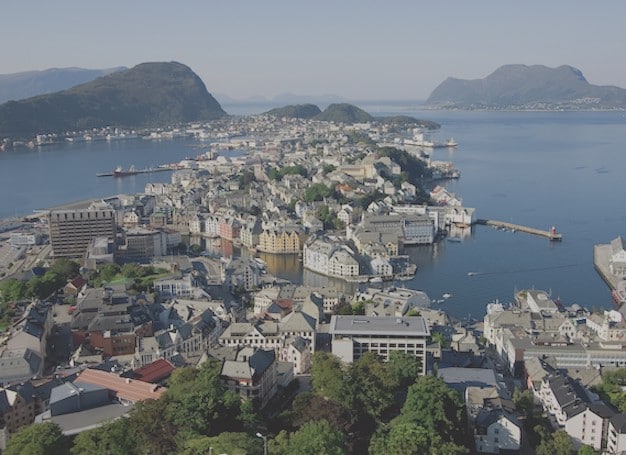
View from Mt Aksla of the city of Alesund and surrounding mountains. Photo by Terje Rakke
By Liz Campbell
Walking through Ålesund in the Sunnmøre region of Norway is necessarily a slow stroll; there’s just too much to take in. Most of the 66,000 inhabitants of this main city in Southern Norway depend on the sea for their livelihood, and there’s even a fishing museum celebrating its heritage. But this does not look like a fishing village.
Towers, turrets and imaginative ornamentation decorate graceful buildings in shades of pink, yellow, blue. Small details – faces, flowers, animals – give each a unique design. It feels as if I have wandered onto the set of a fairy tale. And as with any good fairy tale, this happy ending began with a disaster.
On January 13, 1904, this small town was almost completely destroyed as fire ripped through its wooden buildings, leaving more than 10,000 residents homeless. But something extraordinary arose from the ashes.
Rising From the Ashes
Kaiser Wilhelm of Germany had spent holidays in the Sunnmøre Alps. Touched by their plight, he sent ships filled with materials to build temporary shelters to house the destitute community. Then he assisted in its rebuilding, this time in stone and brick, in a striking new design.
The Jungendstil (Art Nouveau) movement was sweeping Europe and the replacement Ålesund was designed by Norwegian architects and master builders who had embraced its organic, nature-inspired motifs.
Art Nouveau believes that art should be part of everyday life. Thus, buildings, their furnishings, and even functional edifices like railroad stations, all incorporate highly stylized, flowing curvilinear shapes. Grand, imposing construction gave way to clean lines, curved glass, simple decorative touches, and most strikingly, to color.
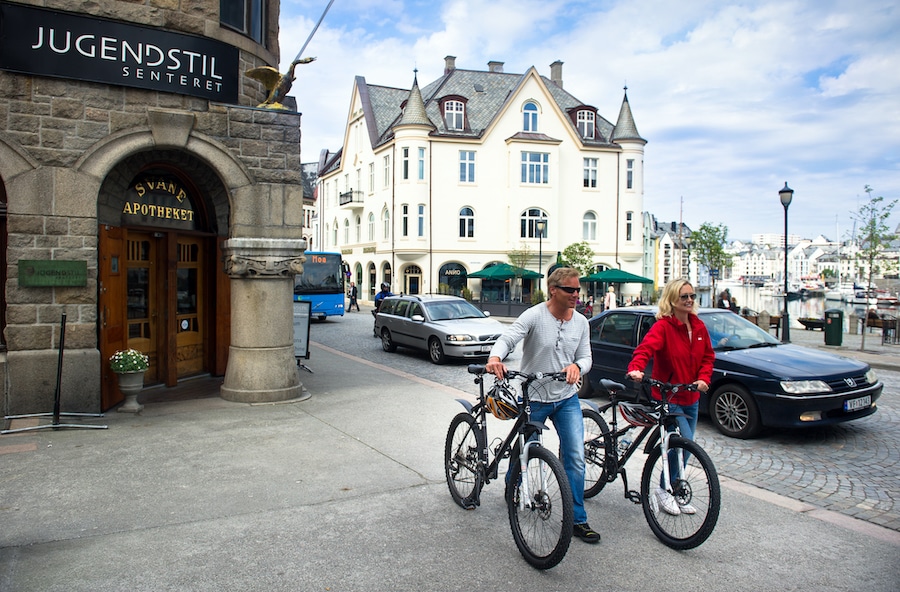
Visit the Jugendstilsenteret National Interpretation Center to learn more about Art Nouveau. Photo by Sverre Hjornevik, Destination Alesund
At the Jugendstilsenteret National Interpretation Centre, visitors can learn more about the rebuilding of the town and the Art Nouveau movement. Ålesund is a partner in the Réseau Art Nouveau Network, a European network of cooperation created in 1999 to protect and foster the development of Art Nouveau. It includes cities like Glasgow, Barcelona and Vienna. But among these, Ålesund is somewhat unique in having started with a clean slate after the fire, and it has held fast to Art Nouveau dictates.
Each turn along its winding streets reveals new colorful architectural features. And scattered through the city are public art installations. Some, like the newspaper boy waving from a street corner, are whimsical. Most, like the woman cleaning herring, simply tell the story of this town. She, like the young fisher boy overlooking the inner harbor, his large sou’wester hat a favorite perch for seagulls, is a reminder of its seafaring history.
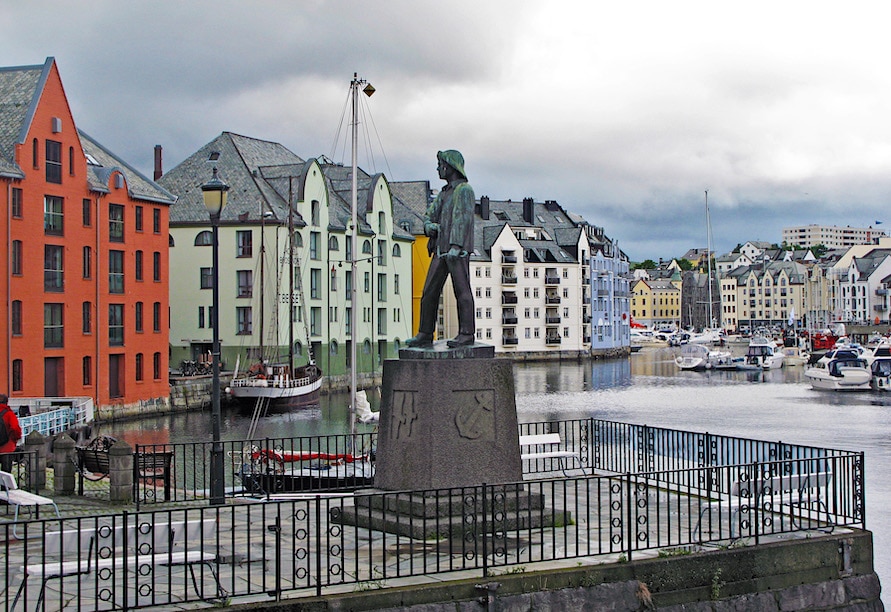
Sculpture of the fisher boy overlooking Alesund harbor
One remarkable bronze commemorates a history few people know. A sailor standing on the bow of a small boat pays tribute to Englandsfarten, the North Sea traffic during World War II. At great personal risk, some 300 boats of all sizes transported to Scotland more than 3,200 people escaping the German occupation. Many Norwegians were executed for their role in this rescue that carried on throughout the war.
An Encounter with the Egg
Wander further along and you’ll arrive at the Aalesands Museum and there, outside it, is a giant metal egg! Nautilus? Death Star? Whose imagination created this?
Inside the museum, sitting in a replica of the egg’s interior, the curator, Ole M. Ellefsen, tells me its story. Designed by a local seaman, Ole Brude, who had seen too many lives lost to exposure in open lifeboats, the egg is actually a lifeboat. It was christened Uræd (Fearless).
In 1904, France offered a prize of one million francs for an improved lifeboat design, to be awarded at the St. Louis World’s Fair that year. “Brude and three friends heard about this. They decided to sail to America in the egg to prove its sea-worthiness and claim the prize,” explains Ellefsen. “But there were many storms that summer and they prevented them from arriving in time.”
When they did arrive, he tells me, they made quite an impact. It’s not hard to imagine the astonishment citizens of Gloucester, Massachusetts felt when a giant metal egg arrived at Pavilion Beach in January 1905, and four bedraggled sailors emerged.
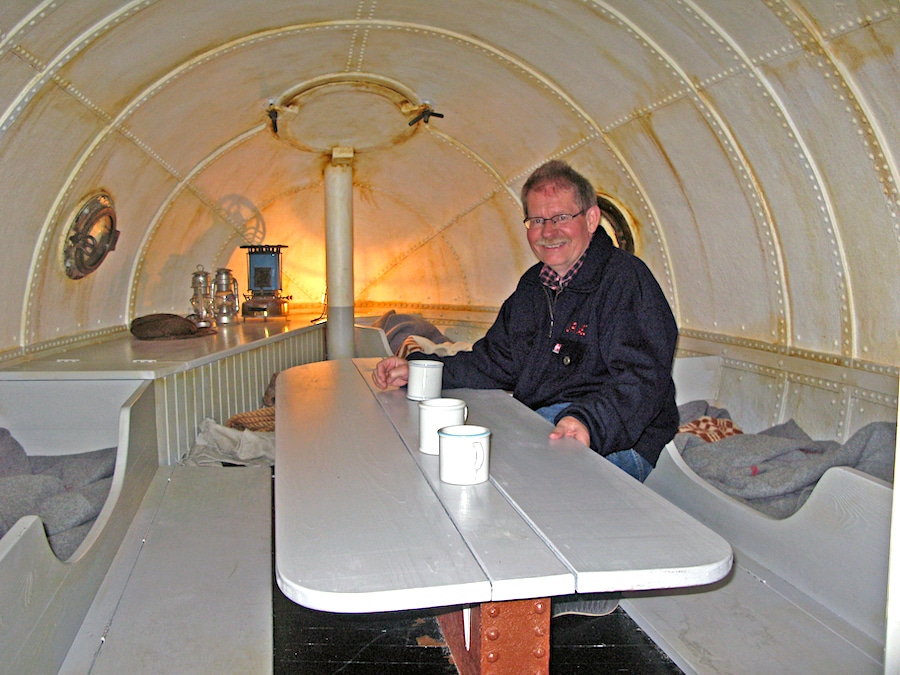
Not a bad place to wait for rescue from a shipwreck. Aalesands Museum curator Ole Ellefsen takes a moment to enjoy the water-tight interior of Uræd, the egg-shaped lifeboat designed in Norway. Photo by Liz Campbell
Ellefsen has written a book about Brude and his unusual lifeboat. While it didn’t win the money, he tells me, his design was used to build 34 Brude lifeboats. “One saved the lives of 20 Spanish sailors whose ship was torpedoed during World War I,” he says. “And because of designs like this, enclosed lifeboats would become a safety standard.”
A Norse Hero
Leaving the museum, my meanderings continue to the town park where a statue of Kaiser Wilhelm II naturally commemorates his generous assistance after the devastating fire. But another statue pays tribute to a local Norwegian character.
This is Rollo, a Viking hero and apparently a forebear of William the Conqueror, the first Norman King of England. Norsemen settled in Normandy in France during the 10th century – hence the name. This statue was a gift of the city of Rouen in 1911. According to legend, (of course, there must be an improbable story attached to a Norse hero), Rollo was given the nickname Gange-Rolv – the walker – because he was so tall that he had to walk even when he was on horseback! We all love a tall tale!
But the sun is beginning its downward journey so it’s time to climb the park’s 418 steps to the top of Mount Aksla. The summit offers a stunning view of the town below and its dramatic place in the landscape. Indeed, there’s no doubt that while human hands have played an impressive role, nature has contributed significantly to the appeal of this part of Norway.
Sprawling along several islands in the picturesque harbor of Brosundet, Ålesund is peculiarly blessed with sweeping vistas where mountains and the ocean intersect. And this town is the gateway to one of Norway’s most iconic fjords.
Geirangerfjord, with its distinctive S shape, has been described as the jewel of Norway’s fjords and is one of the reasons Kaiser Wilhelm loved to vacation in Sunnmøre. From Alesund, one can sail into this imposing passage, its cliffs punctuated with cascading waterfalls and the occasional quaint mountain farm. Small wonder Geirangerfjord is on UNESCO’s list of World Heritage sites.
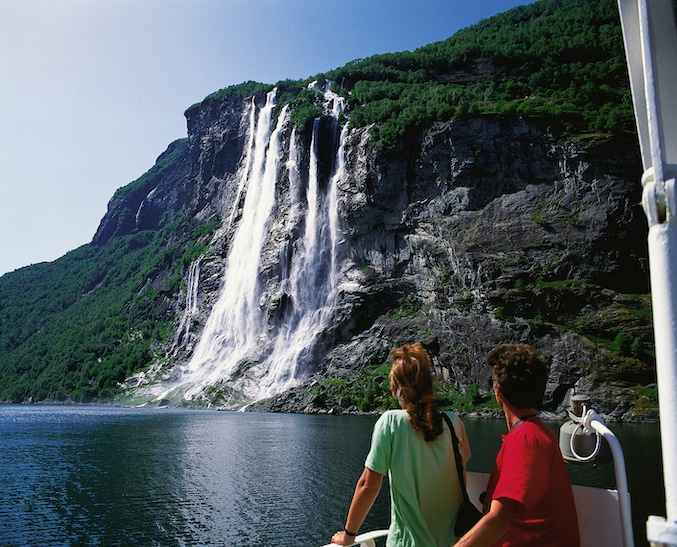
Seven Sisters waterfall seen from a boat in Geirangerfjord. Photo by Frithjof Fure, Fjordnorway.com
Learning to Walk
The fjord terminates at the town of Geiranger, dominated by the historic Union Hotel. Family run since 1897, the Union’s distinctive gables stand out in every photograph of the town. From my bedroom window, the colors of the fjord and surrounding peaks change with the sun’s progress and make the television set a pointless accessory.
But I’m not here to sit. I’m going to learn to walk.
At the Nordic Walking Centre in town, I get my first lesson in Nordic pole walking. The key is to keep the knees slightly bent and swing the poles as you stride along, an efficient and comfortable movement which proves remarkably easy to learn.
“Nordic walking began to keep cross-country skiers in shape during the summer,” explains instructor, Ove Skylstad. “It’s very healthy and even non-skiers see the benefits.”
Normal walking utilizes only 70 percent of muscle mass, impacting mainly the joints of the legs and feet. Nordic walking increases energy consumption as much as 46 percent. It can also increase upper body muscle endurance by 38 percent in just 12 weeks. It doesn’t take long to get into the rhythm as we set off up the mountain.
Hiking these slopes is one reason why visitors come to Geiranger. Craggy rocks and grassy meadows lead gently upward, past streams and small cascades as we climb to our destination, Storsæterfossen. It’s a long hike up but well worth the effort.
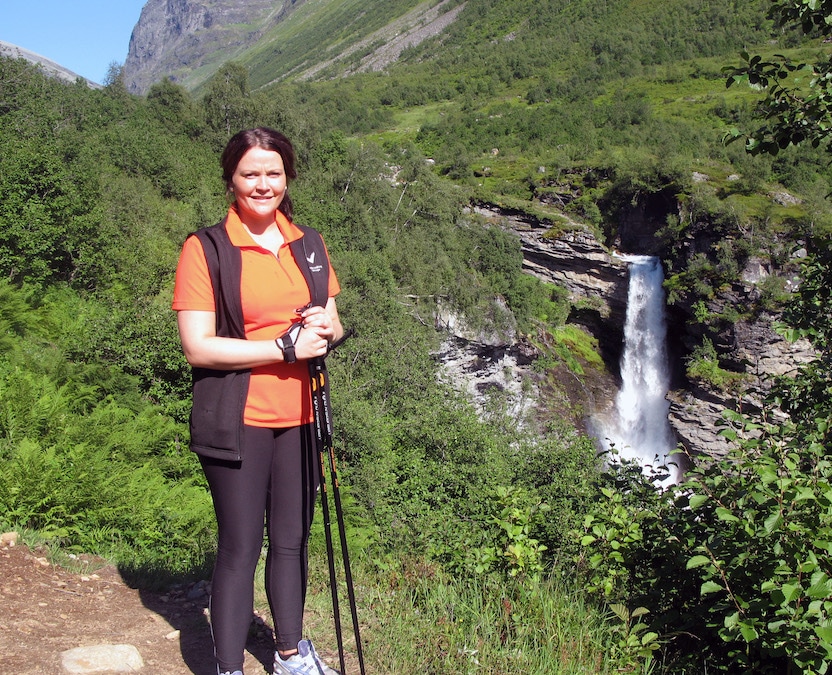
Walk like a Norwegian. You can with two Nordic walking poles and a brief lesson at the Nordic Walking Center in Geiranger. Photo by Liz Campbell
Tumbling 30 meters (100 feet) from the cliffs above, this waterfall began its descent with water from a glacier high above. I can’t resist clambering down the rocky path behind the falls to dip my hands into the icy spray, a cool reward.
The hike back down is faster, the Nordic poles now being put to good use as a brace on the muddy sections of the slopes. After nearly four miles (6 km) of Nordic hiking, it’s time for a treat at the Union Hotel’s spa – a hammam massage.
Originating in the Middle East, the word hammam means ‘spreader of warmth.’ Using water as well as hot stones, the masseuse kneads the knots hiking has left in shoulders, arms and legs. Because of his efforts, my muscles don’t complain the next day.
A View and a Troll
Before leaving Geiranger, two more stops are essential. The first is a trip up the mountain to Dalsnibba. Though it is possible to hike the steep 6 km route from town, the inexpensive local bus or a taxi are more comfortable options. From this high vantage point, the iconic view of the town and fjord far below is awe-inspiring.
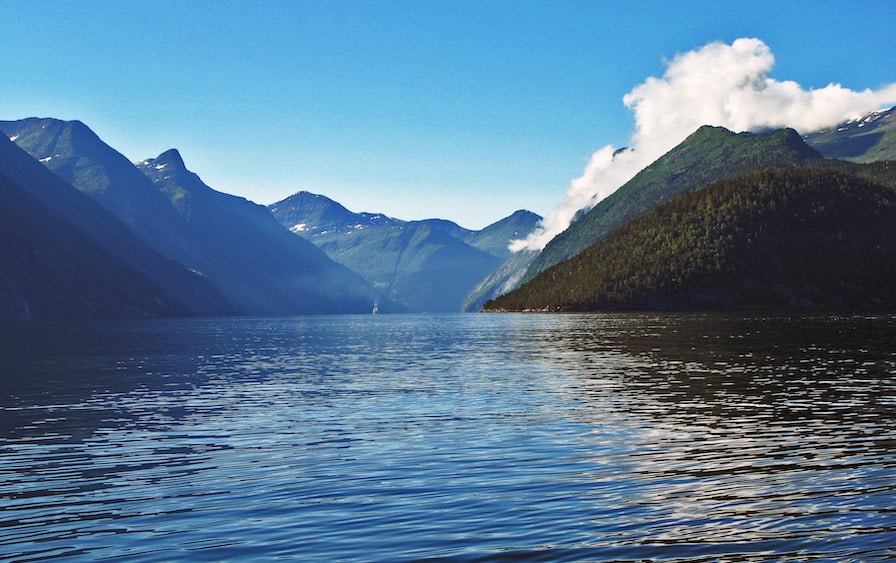
Norwegian fjords make you want to read a Viking saga. Warriors fallen in battle were dispatched to Valhalla on flaming boats set adrift in the fjords. Try to spot the passenger ship heading directly toward you. The perspective hints at the size of the fjords. Photo by Liz Campbell
Indeed, nature here has a way of reminding us of our own puny limitations. The huge cruise ships in the blue fjord below are tiny, insignificant toys, while the surrounding mountains seem massive and imposing. Breathtaking is an entirely apt description.
Because this is Norway, and the chatty bus driver has provided a lesson about trolls, I can’t resist looking for this Nordic answer to hobgoblins in the craggy rocks above. And therein lies the second essential stop.
More whimsical, but breathtaking in its own way, is Geiranger’s troll – huge, colorful, and definitely ugly enough to take your breath away. Sitting by the dock in town, he wears a big smile. Nowadays, these mythical creatures are usually depicted as cheerful, but in Nordic mythology they are usually dangerous. Their saving grace seems to be that they are stupid and can be easily tricked, (think of The Three Billy Goats Gruff).
In a famous Norse story, a boy challenges a troll to a porridge eating contest, then tricks the troll by surreptitiously putting his own porridge into a sac inside his shirt. The ending varies according to the teller’s tolerance of gore. In one version, the troll bursts with too much porridge. In another, the boy tricks him showing him the porridge in his ‘stomach’ and telling the troll he can split open his own stomach so he could eat more. Either way, the troll population is reduced by one.
The Inefficacy of Sunscreen
The bus driver cheerfully informs me that trolls can be found all over the mountains. You see, he explains, “Trolls live in forests and mountain caves and are active at night. But if a troll comes into the sunlight, he turns to stone.” (In Lord of the Rings, Gandalf saves the dwarves from being cooked by three trolls by tricking them into remaining outside until sunrise.) One can spot one of these petrified trolls, he assures me, in the jagged shapes of the mountain and fjord landscapes. “Look carefully,” he grins.
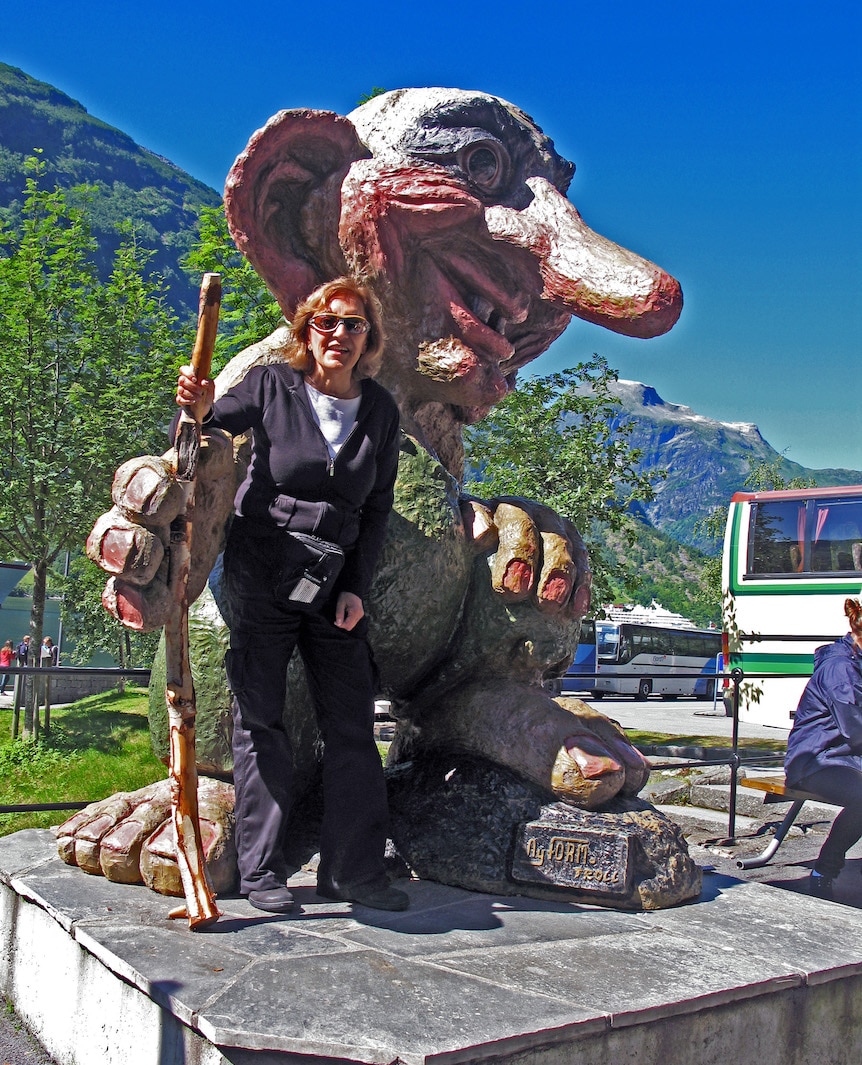
The Geiranger troll is huge and smiling but according to legend trolls can be nasty creatures. Fortunately, this troll, having spent too much time in the sun, is harmless.
It’s not hard to understand why Sunnmøre had such a special place in the heart of a German king. This is a land where nature plays its part magnificently. But here, the inhabitants too, both human and mythical, improve the encounter with charm and whimsy. ![]()
Liz Campbell has been a freelance travel and food writer for more than 20 years. Her recent stories for EWNS include an exploration of fairies in Ireland, the bizarre Yukon outpost of Dawson, the tiny country of Malta, Buffalo, NY. and the lively people of Newfoundland.

